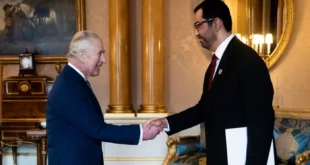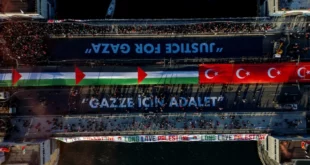Different units are increasingly divided between those who want to play a role in Iran’s regional strategy and those who want to be a more local Iraqi force.
Iraq’s politics may be getting even more divided after the acting Prime Minister, Adel Abdul-Mahdi, sought to affirm his office’s control over key Iraqi paramilitary groups. The powerful Hashd al-Shaabi or Popular Mobilization Units have been maneuvering to dominate Iraq since the ISIS war, but they are increasingly divided between those who want to play a role in Iran’s regional strategy and those who want to be a more local Iraqi force.
A letter from the Prime Minister’s office emerged last week in which four brigades of the PMU, some 15,000 men, could be moved from the control of the PMU to the Prime Minister’s office. This would effectively remove them from control by key pro-Iranian influence such as a man named Abu Fadak, who replaced Abu Mahdi al-Muhandis after the US killed MUhandis and IRGC Quds Force leader Qasem Soleimani in January.
The real story is more complex. The PMU were formed in 2014 after a fatwa by Iraq’s most well known cleric, Ayatollah Ali Sistani. They were intended to be a popular mobilization of young men to fight ISIS. Some of the units that joined were historic Iraqi militias that are aligned with Iran. These included Kataib Hezbollah, Harakat Hezbollah al-Nujaba, Asaib Ahl al-Haq (AAH) and the Badr Organization. Leaders of these groups such as Muhandis and Hadi al-Amiri of Badr had fought alongside Iraq against the Saddam Hussein regime in the 1980s. Muhandis was a wanted terrorist. Qais Khazali of AAH was once detained by the US at Camp Cropper.
The PMU that emerged in the fall of 2014 was also made up of territorial brigades linked to kay Shi’ite shrines which were also linked to Sistani. These included fighters from Najaf, Karbala and other cities. After ISIS was largely defeated in 2017 the PMU’s future was uncertain. Iraqi Prime Minister Haider al-Abadi wanted to make it an official force and saw it as the hope of the future of Iraq. Others wanted the units to go home and have just the Iraqi army as Iraq’s main military force. Iran wanted the PMU to become Iraq’s version of the IRGC, a kind of Hezbollah-IRGC in Iraq. Iran was thus happy to see the increasing role of Muhandis as deputy of the PMU.
Iraqi politics changed in the fall of 2019 when protests broke out in Shi’ite areas of southern Iraq. The protesters targeted Iranian consulates and offices of Badr and other groups. In response pro-Iranian elements of the PMU sent the Khorasani militia members of the PMU to kill protesters. Other groups, such as Khazali’s AAH also killed protesters. This caused Iraqi Prime Minister Adel Abdul Mahdi to resign. Behind the scenes Muhandis ordered his militia to conduct rocket attacks on US forces in Iraq, resulting in the deaths of US-led Coalition members. The US responded with air strikes. Hadi al-Amiri maneuvered to work with Muqtada al-Sadr, leader of Iraq’s largest party, to remove US forces from Iraq.
All of this put the PMU in an awkward place. Because it was an official force it was not supposed to act independently and target Americans who were working with Iraqi Security Forces. Sistani was also concerned that his units were being drawn into suppression of protests. Iran was scrambling at the same time to fill the void left by Muhandis and Soleimani, sending Hezbollah members to try to unify the PMU. Iran appeared to stumble in March as internally the Sistani factions of the PMU rejected the role of Muhandis’ successor Abu Fadak and also were not kind to Soleimani’s replacement, Esmail Ghaani during a visit in early April. They approached the Prime Minister and Defense Ministry to suggest moving their units and minority groups out of the PMU.
At the same time Iraqi politics was in turmoil as no new prime minister could be found. Amiri and Sadr worked to torpedo two prime minister candidates in February and March. April arrived with yet another new man trying to become Prime Minister. Abdul Mahdi, who had tried to rein in the PMU in the summer of 2019, decided he was acquiesce to the push to move several brigades away from the PMU’s control. He has now written a letter seeking to move the Imam Ali Combat Division, the Liwa al-Akbar unit, the Al-Abbas Combat Division and the Liwa Ansar al-Majaya under the PMO’s control. These units are mostly territorial brigades linked to Najaf and Karbala and varies shrines. This could split the PMU into two groups: The minority units and Sistani’s supporters and those linked to the IRGC and Iran.
The pro-Iran units include Badr, Kataib Hezbollah, Asaib Ahl al-Haq, Saraya Khorasani, Kataib Imam Ali, and Harakat Hezbollah al-Nujaba. What is at stake is a large budget and access to some 150,000 fighters. This is a lot of men with combat experience fighting ISIS. The PMU also controls checkpoints, and areas along the Syrian border. It has economic interests as well.
The current crisis within the existing Iraqi crises appears to indicate a rift between the hard core members who want Iraq to be a springboard for Iranian activities in the region and those who want to focus on more local issues. For instance Iran has transferred ballistic missiles to Iraq. Iran seeks to move weapons to Syria via Iraq. All this has provoked tensions with the US and also tensions with Israel in a regional context. The question for the PMU is whether it is becoming a state within a state, with its own prisons, businesses, checkpoints, and munitions warehouses, or whether it will actually integrate into the security forces. It receives handsome salaries from the government which is a way to sponge up state resources. This is in line with Iran’s overall goal to use Iraq as its “near abroad” and make Iraq dependent on Iran. Already Iraq is dependent on Iran for electricity, even though Iraq ostensibly has massive amounts of oil and should be wealthy. With oil prices low the Iraqi government budget is imperiled. This will cause the PMU to exert more control. But the drive for control may have also created this internal rift.
Iraq lacks a new Prime Minister. It has disputes with the Kurdistan autonomous region. ISIS is rising again. The US is leaving many Iraqi bases and Coalition forces have returned home due to the coronavirus virus. The latest shakeup in the PMU is yet one more fragmentation. Iraq’s divided and multi-layered security forces increasing lack accountability, as some of the PMU were involved in killing protesters and firing rockets at US forces, and that means Iraq will have increasing trouble exerting government authority or systematic policies.
 Eurasia Press & News
Eurasia Press & News


